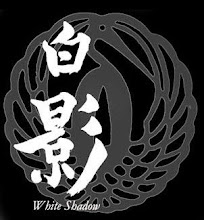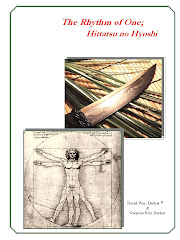
Kiku Matsuda
State of the Art:
More than eight hundred years after the Mongol invaders were repulsed, men are still making katana in the same basic style that emerged from the knowledge gained in those battles. Some of these are made of tamahagane, smelted the old way. Other katana are made using "State of the Art" powdered Swedish steels and modern metallurgy. The evolutionary process of blade design may have slowed, as wars are waged remotely using laser guided missiles and satellite guided drones, but blade evolution has not stopped completely. Maybe the question is whether it is evolution, or intelligent design, that feeds the creativity of today’s generation of knife makers?
In my new book, When Two Tigers Fight, I will be discussing the tantoesque-Bowies, Bowie-fied tanto, and Indo-Euro-Asian hybrids. These exciting new trends in knifemaking are obvious examples of cross-cultural pollination, the fruits of our world growing smaller and smaller. But, how often do we see true evolution, or innovation, within an already timeless design? The "Full Contact" Fighting knife is only one example of Kiku Matsuda’s evolution of the timeless. There are many more examples of his work to be found at http://www.japaneseknifedirect.com/ .
After only a few moments spent looking over his knives on the Japan Knife Direct website I bought what he calls his back-up knife. One of the reasons I bought this small knife was because most of the other sizes were already sold! At 7.25 inches overall, this is a perfect sized back-up every-day-carry knife. The 3.25 inch blade was delivered razor sharp! The quality of the grinding and the overall knife fit and finish is excellent! It came fitted with a compact, perfectly fit kydex sheath. Although most people like them, I am not a fan of the Techlok™ system on a small knife sheath because it makes it unnecessarily bulky. In my opinion the mini Full Contact is a superb knife capable of providing you with a sure defense. Kiku san uses a unique lanyard arrangement on his knives that at first glance seemed awkward. I soon discovered that if you slid your fingers between the grip and the lanyard you could actually let go of the knife without dropping it, freeing your hand for other tasks. Close your fingers and the knife comes right back to where it should be, ready to be used again. This is a far better system than having a single lanyard placed at the butt.
Anyway, within five days of placing my order I had my new Kiku Mini "Full-Contact" fighting knife in my hand and a day later I placed an order for a full-sized version as soon as one might come available. Jemmy Iwahara quickly contacted a knife store and procured one of these rare knives for me and within a week it too arrived at my door. The ha
 nd ground nine inch blade on my full sized "Full Contact" has the blade shaped in the traditional hamaguri-ba (apple seed) profile, known for its strength and fearsome cutting ability. The length of the tip is somewhere between an O-kissaki and a chu-kissaki in size and it is gracefully curved like the tip of a katana. Moving further back along the blade, where the yokote would normally be, we find instead a distinct transition line that delineates between the slightly reinforced tip and the beginning of the primary edgei. The primary edge, like the tip, is hair shaving sharp. A six inch long beveled false edge mimics the Ihori style mune, but unlike its feudal predecessor, it is sharpened adding to the blade’s overall functionality. Replacing the traditional frosty hamon is a unique pattern created by a special acid etch. This etch is said to increase rust resistance while eliminating surface reflections. Resembling a Jackson Pollock canvas, the etched blade surface adds an interesting artistic touch. In place of the clay hardened blade of old is one manufactured from a modern steel, along with its attendant special heat treatment to ensure edge retention and improve cutting.
nd ground nine inch blade on my full sized "Full Contact" has the blade shaped in the traditional hamaguri-ba (apple seed) profile, known for its strength and fearsome cutting ability. The length of the tip is somewhere between an O-kissaki and a chu-kissaki in size and it is gracefully curved like the tip of a katana. Moving further back along the blade, where the yokote would normally be, we find instead a distinct transition line that delineates between the slightly reinforced tip and the beginning of the primary edgei. The primary edge, like the tip, is hair shaving sharp. A six inch long beveled false edge mimics the Ihori style mune, but unlike its feudal predecessor, it is sharpened adding to the blade’s overall functionality. Replacing the traditional frosty hamon is a unique pattern created by a special acid etch. This etch is said to increase rust resistance while eliminating surface reflections. Resembling a Jackson Pollock canvas, the etched blade surface adds an interesting artistic touch. In place of the clay hardened blade of old is one manufactured from a modern steel, along with its attendant special heat treatment to ensure edge retention and improve cutting. If you are a Strider-oholic or stuck on Mercworx, the Iwaharas and Kiku san have a cure, but it is not a cheap one. Kiku san’s knives are extraordinary pieces of art and edged weaponry and they are priced accordingly. Those who know quality won’t balk at the price and those with deep pockets who love beautiful knives can fulfill their desires at Japan Knife Direct. There are at least four other Kiku knives I would like to own. If you see one you like, buy it right then, because Kiku san’s knives do not hang around very long. Jemmy and Koki Iwahara will give you world-class service, with great communications, and some of the quickest shipping on the planet. Invest in the State of the Art, buy a Kiku Matsuda masterpiece, and tell them I sent you.
PS: Kiku san's knives will be among those featured in our second book, "When Two Tigers Fight."






No comments:
Post a Comment